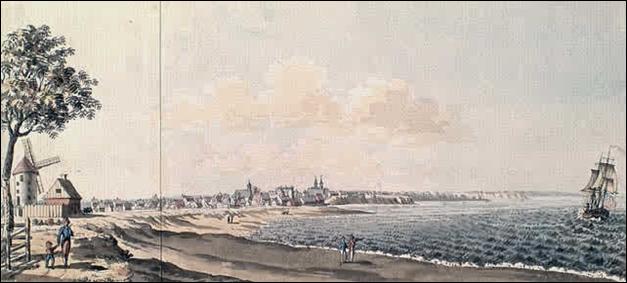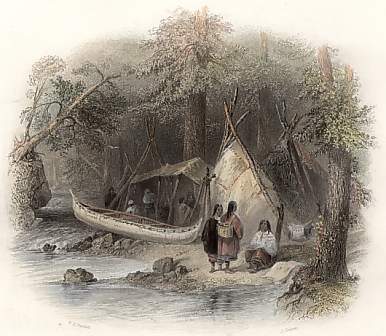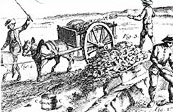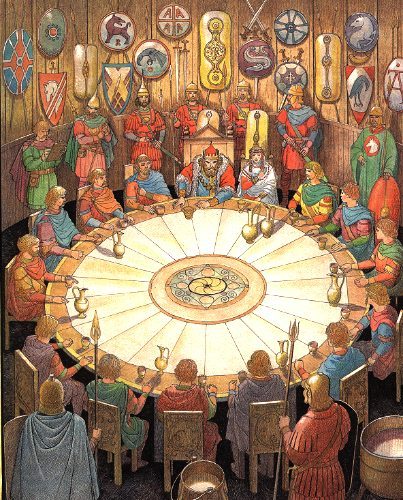Trois-Rivières

A romanticized depiction of Trois-Rivières c. 1700 by James Pichy.
A translation of what Champlain noted in 1609 upon seeing Trois-Rivières...
"... Trois-Rivières is a passage. All the terrain that I see is sandy..., elevated enough and covered with pines and evergreens along the edge of the river...."
It was also a stopping place for Algonquins.

It would seem any history of Trois-Rivières would have to include the people who occupied the land for centuries prior to Europeans arriving on the continent.
When Jacques Cartier travelled up the St. Lawrence River and planted a cross in 1535 on what would become called Île Saint-Quentin, he was met by the people who had always been there... likely Algonquins. In 1603, someone estimated that the combined population of the various Algonquin tribes was somewhere in the neighborhood of 6,000.
From the start, it was understood by Champlain that an alliance with the native people was necessary for success in the fur trade. French interpreters working for companies like the 100 Associates spent years living among these people learning their language. A well-known ancestor, Jean Nicolet de Belleborne was among them.
Author Thomas Costain summed up the colony as such...
'This small settlement had become the meeting ground of the hardy spirits who had an itching of the foot, the coureurs de bois. Québec was the port, the administrative center of New France: Montréal was a brave experiment, an outpost existing in a state of spiritual fervor; Trois-Rivières was the starting point of exploration. Woodsmen had fallen into the habit of making it their winter quarters.'
Source:

An abbreviated timeline...
1541: Jacques Cartier, while looking for gold and diamonds, found "a fine mine of the best iron ore in the world...." However, it would be another 200 years before Canada's iron ore mines were actually worked. Politics and economics continually got in the way.
1617-1618: Samuel de Champlain, projected an optimistic 1 million livres in revenues from the iron deposits found in the area.
1634: Under the orders of Champlain, LaViolette travels to the mouth of the Saint-Maurice River to found a fur trading post and build a fort on 'le Platon', a plateau situated on a hillock of land along the St. Lawrence River. The fort would enclose a few homes and shops, and the settlement would become known as Trois-Rivières. For a long time, this site will be one of the most advantageous for the activities of fur traders.
Seigneuries were created… such as the fief Hertel in 1633, the Jesuits fief in 1634 and the fief Godefroy de Lintot in 1637 among others. However, despite a few attempts, no one inhabited the seigneuries because of the Iroquois problem.
Between 1634-84 at least four chapels were built under the direction of the Jesuits. The first one, as described by them, was "...nothing but a few wooden logs joined together, covered with a little soil and grass...." The first missionary of the three rivers region was Father Jacques Buteaux, who arrived in September 1634 accompanied by Father Le Jeune. In 1639, he was made Superior of the congregation. Some Montagnais and Algonquins had settled nearby on Cap-de-la-Madeleine which Father Buteaux encouraged because he wanted the presence of an agricultural community and felt they would also provide some protection against the Iroquois. Champlain had told him that some men from Trois Rivières could be used to work alongside the Amerindians to clear and cultivate the land. Conflicts arose with M. de la Potherie, the Governor of Trois Rivières, for he was of a different mind. Since Jacques Buteaux had the rights to the land, he prevailed, and in 1649, in the name of the Jesuits, he officially conceded the land to his chosen settlers. Among the 14 men picked to settle the Cap-de-la Madeleine region were Pierre Guillet and his brother, Mathurin, also ancestor, Jacques Aubuchon. In 1651, a notarized act confirmed these concessions. Father Buteaux was killed by the Iroquois in May of 1652,
Between the years 1648-51, forty or so colonists, some with their families, did establish themselves at Trois-Rivières. They enclosed the town in a stone palissade. In 1663, a map shows 50 or so lots. But it wasn't until the end of 1663 with the dismissal of the Company of 100 Associates, the oversight of King Louis XIV in establishing New France as a Royal colony instead of a fur-trading colony, and the arrival in 1665 of the Carignan-Salières Regiment, that the population was able to increase. A renewed interest in iron mining was displayed by the Crown.
When the 1666 census was taken at the end of July, Trois-Rivières had a population of 602, Montréal 760 and Québec 2,857, for a total of 4,219 people in Canada. The average age of the habitants of the Trois-Rivières region was approximately 13 years old. (Source: "La population du Canada en 1666" by Marcel Trudel and published by "Les éditions du Septentrion", Sillery (Québec), PQ, Canada)
In 1704, new fortifications were built to protect the habitants from the incessant Iroquois raids. Twenty-eight houses were within the fortifications, and several others were built on the edge of the river. A windmill, situated nearby, served to grind the grain and also as a shelter in case of attack.
In 1730, the iron works, des Forges du Saint-Maurice, were started. With this, Trois-Rivières became Canada's first industrial area. In 1738, the forge was producing iron bar and castings such as pots, utensils and stoves from high-quality iron ore extracted from the surrounding bogs and swamps. ... iron ore An imaginary scenario: If in 1666, one could gather around a table all of the heads of families from the Trois-Rivières region who were my ancestors one would have (age according to the census): 65 year-old Michel LeNeuf from Normandy, a seigneur, sitting beside his brother-in-law... 58 year-old Jean Godefroy also from Normandy, another seigneur 46 year-old Antoine Desrosiers from Lyonnais, a carpenter and son-in-law of Michel LeNeuf 32 year-old Pierre Boulanger from Normandy, a corporal in the Carignan-Salières Regiment newly arrived in Canada the previous year. In a few years he would become the son-in-law of Jean Godefroy. 36 year-old Marie Boucher from Normandy, widow of Étienne de la Fond 36 year-old Claude Jutral (Jutras) dit Lavalée from Paris, a habitant 43 year-old Jacques Aubuchon from Normandy, widowed master carpenter living with his 5 sons and one domestic. 30 year-old Louis Tetreau from Poitou, a habitant 44 year-old Quentin Moral from Lorraine, seigneur de St. Quentin, and his wife Marie Marguerie. 38 year-old Jacques Ménard dit LaFontaine from Poitou, habitant 42 year-old Étienne Gelineau (Gelinas dit Bellemère) from Saintonge, a widower living with his son, Jean... both carpenters 30 year-old Jean Cusson from Normandy, a notary 30 year-old Louis Pinard from LaRochelle, a master surgeon, a son-in-law of Marie Marguerie. 40 year-old Pierre Guillet dit La Jeunesse from LaRochelle, a carpenter living with his wife and ten children, plus one domestic 36 year-old Michel Lemay from Anjou, a habitant and eel fisherman 50 year-old Pierre Lefebvre from Paris, a habitant Several ancestors were immersed in the fur trade... for many it was their only reason for being in New France. Trois-Rivières was the area they chose as a base, and in time, plant a garden and raise some children... and their many of sons would follow suit. The business of voyageur and coureurs de bois was a young man's game, after all. Thirty-three ancestral families in all who fought, intermarried, lived and died dependent on one another. Some were landed gentry from Normandy, a couple were notaries, about eight were soldiers, others were contract workers and fur traders. They were: AUBUCHON, Jacques BELLEMÈRE, Étienne... can also be Gélinas or Gélineau dit Bellemère. A widower, he arrived in Canada with his 12-year-old son, Jean. Étienne Gelinas was 34. He had been recruited/contracted by Pierre Boucher in LaRochelle, France May 11, 1658. Bellemère was a carpenter and wood carver. BOULANGER, Pierre... dit names LeBoulanger or St. Pierre. Boulanger was a merchant and a corporal in the Carignan Regiment. He arrived in Canada in 1665. Around that time, he testified, along with Jacques Aubuchon, against Madame Crevier that she sold alcohol to Indians. A serious offense at that time. In 1667, Boulanger took part in an inquest concerning the traficking of alcohol with the Indians. In 1677, he married Marie-Renée Godefroy. BOURGIS, Jean-Baptiste... also can be spelled Bougery. Bourgis left France with his wife, Marie Gendre, and 6-year old son from the port of LaRochelle in 1650. He died in 1657 in Trois-Rivières. Daughter, Marie Bourgis, who was born in Trois-Rivières, married Louis Robert in January of 1666. Four of her sons, Pierre, François, Jean-Baptiste and Jacques Robert were all involved in the fur trade. BOUTON, Antoine... signed up from LaRochelle, France, for passage (engagé) to Canada in June 1698. He was a sheetmetal worker, a blacksmith and a laborer. He appears to have been in Trois-Rivières as a settler and farmer. In 1732, he sold a garden situated in the lower town of Trois-Rivières to Pierre Lefebvre, a master butcher. On the 5th of October 1734, he sold land measuring 3 arpents (approx. 2-1/2 acres) of frontage at the fief of Tonnacour to ancestor Michel Girard of the same fief. COUC, Pierre CUSSON, Jean DESROSIERS, Antoine DUBOIS, Antoine... was from Saintes, Saintonge, France where he was born around 1648. He probably arrived in Canada as a contract worker sometime after 1666 since he doesn't appear on the Talon census of that year. In November of 1682, he married Marie-Marthe Moral, the daughter of Quentin Moral and Marie Marguerie, in Trois-Rivières. In doing so, he married into a family of fur traders and merchants. Their youngest daughter, Marie-Claude Dubois, born about 1693 is an ancestor. DUCLOS, François... left the Calvados region of Normandy for Canada around 1665 where he married a fille-du-roi, Jeanne Cerisler from Touraine, in November 1665. She was 24, he was 38. The family is listed on the 1666 Talon census as living in the Trois-Rivières area. At the time, he was a volunteer and a habitant. They did not appear on the original census, but on the reconstructed census. In time, two of their sons, Nicolas and Charles were involved in the fur trade. Charles, however, died young at the age of 20. DUREAU, Pierre... whose dit name was Poiteven arrrived in Canada before 1707 as a sergeant in the company Saint-Martin des troupes de la marine (colonial troops). Pierre Dureau was baptized in the parish of Saint-Paul de Poitiers in Poitou, France. He married Marguerite Gélinas dit Bellemère in September of 1707 in Trois-Rivières. Their oldest daughter, Louise Thérèse married Pierre Desrosiers dit Dargie in 1728. It appears that Pierre Dureau and Marguerite Gélinas spent their lives in Trois-Rivieres as settlers and farmers. FOUBERT, Phillippe... a furniture maker, was first mentioned as being in Canada in 1649. He was from Rouen, Normandy and he arrived in Nouvelle France as a emigrant and not a contract worker. His wife and daughter perhaps did not accompany him at the time because there was another daughter, possibly sickly, who died in France in September of 1655 at the age of 8. It appears his wife, Marie Jeffine Rivières, arrived in Canada in the summer of 1656 with a 16-year old daughter. In September of 1656, his daughter Marie married Jean Cusson, who would become a notary in the area. On the census of 1666, Phillippe Foubert he is listed as deceased, and his widow has moved into the Cusson household with her daughter. Records indicate that he died sometime before 1662 at the age of about 50. GIRARD, François... was born in Canada in 1673, the son of Pierre Girard dit Guilbert, a mariner in 1669 and Suzanne DeLaVoye who had arrived in Canada around 1666. In July 1703, François Girard was granted a coveted congé or passport to travel west. The west, in this case, was probably no further than the Great Lakes. To control the fur trade and collect appropriate taxes, the French government issued passports (permits), which were a form of license. They were difficult to acquire since in many years only 25 were issued. To conduct fur trading or to travel west without a passport was considered illegal and subject to punishment, most often in the form of fines or confiscation of furs. When François Girard married Canadian-born Antoinette LeMay around 1709, he was marrying into a well known fur-trading family. Their oldest son Joseph, married to Marie-Anne Vanasse is an ancestor. GODEFROY, Jean GUILLET, Pierre HERTEL, Jacques JUTRAS, Claude LAFOND, Étienne LECLERC, Florent... was born around 1619 in the hamlet of Bray-sous-Faye, Angers, Anjou. In April 1656, he signed up to travel to Canada from LaRochelle, France, no doubt as a contract worker. In February 1658, Florent LeClerc married the widow of Jean-Baptiste Bourgis, Marie Gendre, at Trois-Rivières. She brought four children to the marriage, the youngest being 2 years old. Her daughter, Marie Bourgis married to Louis Robert, is an ancestor. Jean-Baptiste Bourgis had died in Trois-Rivières in November of 1657. Marie Gendre, born around 1622, was from the village of Sugères in LaRochelle, Aunis. After her marriage to Florent LeClerc she had three more children. Son Jean LeClerc dit Blondin, married to Marie-Claire Loiseau dit Francoeur, is an ancestor. Marie Gendre's sons with Florent LeClerc were fur traders. In May 1690, Jean LeClerc dit Blondin received a permit from the French government to travel to the Great Lakes. In June of 1695, he headed up an expedition for travel to the west. His elder brother, Florent also received a permit in June 1695, probably he was part of the expedition. Jean LeClerc was also a respected canon maker. Florent LeClerc died in Trois-rivières in December of 1664. Marie Gendre remarried two more times, in 1667 and again in 1669. She died in Trois-Rivières in 1699. LeFEBVRE, Pierre LeMAY, Michel LeNEUF, Michel (Michel LeNeuf du Hérisson) LOISEAU, Pierre... This individual arrived in 1665 as a soldier in the Carignan-Salières Regiment. In a roster of soldiers, he is listed as Pierre LOZOULT dit LaTour, with the Loubias cie. Various spellings of his name can be Lozault, Lozeau or Lozeaux. He was able to sign his name. In 1671, he was a soldier of the Trois Rivieres garrison, he was also a farmer for sieur ancestor, Godefroy de Lintot. Pierre Loiseau was born in the parish of St. Maurille, Angers, Anjou, France about 1637 . First mention of him in Canada is 9-21-1671 in Trois Rivières at the writing of his marriage contract to the widow, Jeanne-Léonarde GENEST. She had arrived in Canada in 1669 from Nivernais, France, as a fille-du-roi where in November of the same year she married Noël Cardin in the region of Trois-Rivières. In 1681, the family was living in the Lower Town (basse ville) of Québec. The daughter of Pierre Loiseau and Jeanne-Léonarde Genest, named Marie-Claire Loiseau married to Jean LeClerc in 1689 is an ancestor. MÉNARD, Jacques MORAL, Quentin... who, during his lifetime, was a judge and a civil and criminal lieutenant for the king in Trois-Rivières. His exact arrival date in Canada is unknown but it could have been around 1645. He was born in a village called St. Quentin in Lorraine, France about 1620. In approximately 1652, he married the widow of Jacques Hertel. The woman was Marie Marguerie, sister of the well-respected interpreter and fur trader, François Marguerie. Marie Marguerie inherited land on the island called l'Île de la Trinité from her brother, François when he died in 1648. After the Moral-Marguerie marriage, the island was renamed l'Île Saint-Quentin. Besides land, Marie Marguerie brought three young children to the marriage, aged 10 to 3. On 17 November 1663, Quentin Moral was appointed royal notary but does not seem to have taken up the office, which was entrusted a year laber to Séverin Ameau. The 1666 census indicated the family was living in the Québec area... Quentin Moral Sr de st quentin - 44 habitant Source for the above listing: website Alberta Family Histories Society In 1669, Quentin Moral made a concession of 3 arpents of land to Antoine Desrosiers in Trois-Rivières. At the time, Quentin Moral was seigneur of the property, 'L'Arbre-à-la-Croix' in Trois-Rivières. Quentin Moral died in Trois-Rivières in 1686, his wife outlived him by 14 years. MOUET, Pierre NIQUET, Pierre-René... arrived in Canada about 1664 from the Saintonge region of France where he had been born around 1642. Niquet married a fille-du-roi, Françoise Lemoine in June of 1666 at Cap-de-la-Madeleine. She had arrived in Canada the previous year from Paris. The couple had 11 children. One son, Jean Niquet received a permit in 1694 to travel west to the Great Lakes region for the purpose of fur trading. A daughter, Marie Niquet married to Dominique Jutras in 1684 is an ancestor in the Cameron line. A snapshot of the 1666 census of the Trois-Rivières area indicates: Pierre niquet - 24 habitant This family was in Champlain, P.Q. in 1681. PINARD, Louis POTHIER, Jean-Baptiste ROBERT, Louis... whose dit name is LaPommeraye and LaFontaine, arrived in Canada in 1665 as part of the Carignan-Salières Regiment, Laubia Company. He sailed out of the port La Rochelle on the 'Le Saint-Sébastien', a 250-ton ship which carried the companies: DePortes (Duprat), Dugué and La Varenne as well as Laubia. Louis Robert had been baptized in the parish of Ste. Marguerite de LaRochelle in Aunis, France in 1638. First mention of Louis Robert in Canada is 11-12-1665 at Trois Rivières where is a witness to the marriage contract between Nicolas Masson and Marie Gendre. In November of 1666, he married Canadian-born 12-year old, Marie Bourgis in Trois-Rivières. Because of her age, Marie Bourgis undoubtedly remained with her parents until the end of 1670. The first child of Louis Robert and Marie Bourgis was born in September of 1671. This child Pierre Robert was a fur trader who in May of 1694 and June of 1706, received permission to travel west to the Great Lakes region. On 9-16-1712, he sponsored a fur trading expedition. Pierre Robert, along with his younger brothers, François, Jean-Baptiste and ancestor Jacques were all envolved in one way or another with the fur trade. Jacques Robert who used the did name LaFontaine, was granted permission to travel to the Great Lakes 3-19-1715 and 5-18-1717. Louis Robert and Marie Bourgis would have eleven children, including a set of twin boys. One of the twins, Jacques Robert is an ancestor in the Cameron line. The 1666 census indicates Louis Robert was living in the Trois-Rivières area of Québec as a bachelor and a habitant. In time, he would become a cobbler and shoemaker. TÉTREAU, Louis... arrived in Canada from Poitou sometime before the summer of 1663 when he married the widow, Nathalie Landreu. Her first marriage had taken place in August 1659 in Trois-Rivières. It appears as if she was part of the recruitment initiative known as filles à marier whereby women in France contracted to marry settlers in Canada. Nathalie Landreu has one daughter in April 1662 in Trois-Rivières with her first husband, Jean Baudouin. Louis Tétreau and Nathalie Landreu, together, had nine children. Their oldest son, Claude Tétreau, born in 1666 was killed by the Iroquois in September 1695. He was 29 years old. Louis Tetreau was listed on the 1666 census as living in the Trois-Rivières area as a habitant. A snapshot of the census listing is as follows: Louis tettreau - 30 habitant Source for the above listing: website Alberta Family Histories Society Two of Louis Tétreau and Noëlle Landrau's son, Daniel and Joseph-Marie Tétreau are ancestors in the Cameron line. VANASSE, François-Noël (dit Précourt)  .....
.....  being loaded on a cart.
being loaded on a cart.




Marie Marguerise (Marguerie) - 40 sa femme
Jeanne Moral - 13 fille
Marie Moral - 10 fille
jertrude moral - 8 fille
Marthe Moral - 5 fille
Robert henry - 20 domestique
Nicolas dupuis - 24 domestique
françoise lemoyne - 22 sa femme
noelle Landreau - 30 sa femme ve de Beaudouin
Magdelaine Beaudoin - 3 fille
Marie tettreau - 2 fille
Jacques Boissonet - 21 domestique
Jean monet - 19 domestique 

